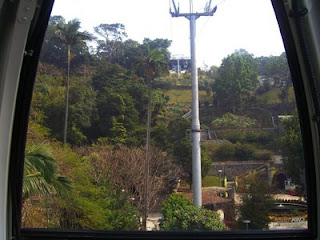Four months ago, when I first went to Macau, I was taken by the vibrant patterns that demarcated the city streets. This time I went back to do more of the tourist things such as visiting the fortress and lighthouse on Guia Hill. I have to admit that I was mostly excited to ride in the small cable car. I have shared my feelings about being suspended in the air so this was a splendidly fearful treat.

As the gondola swayed and slowly ascended the hill I was able to look down and see the paths and secluded areas below. I forced myself to remove my sweaty hands from their death grip on the seat and reached for my camera.
What struck me about the unfolding hillside was how the patterns of the city that captured my interest were slowly winding up the hill. Hardness gave way to softness, a hedge replaced an edge. I was consciously applying the patterns of structure, environment and their relationships to Macau's historic setting. A great read on this is Christopher Alexander, Sara Ishikawa, and Murray Silberstein's A Pattern Language: Towns, Buildings, Construction. It was written in the 1970's but is still as relevant today. A main point of the book is that various public spaces are needed to support institutions for a neighborhood or public setting.
The spaces that I concentrated on that day were the enclosures and intimate spaces along paths and datums that drew the user in. In English there is no real word for this, though it is sometimes described as "emptiness." More accurate perhaps is the Japanese word, "ma," which refers to negative space, or space in between. This is to say that the emptiness is not a void, but has a quality that draws one in.
The various niches that I came across did just that: they provided a very private experience in a public setting. In the words of Johannes Itten of the Bauhaus: matter represents the usefulness, nonmatter the essence of things.



Can you understand the emptiness I described?
Architecture utilizes psychology is spatial design. In the most basic and ancient structures we see how humans seemed to understand our interactions with the environment. A structure that is recessed appears to be more intimate, a descent into what is familiar and known.

A space above is unfamiliar and open. I enjoy hiking to peaks because I feel as though the space around me is unfolding and opening; I can feel my spirit swelling to fill the space.

Other tools include softness and blending of an edge to open up a space so that other areas seem to be an extension of inhabited space...

...or placing a hard edge to signify a border or limit.

but the empty space between them
is the essence of the wheel.
Pots are formed from clay,
but the empty space between it
is the essence of the pot.
Walls with windows and doors form the house,
but the empty space within it
is the essence of the house.-Lao Tse


Comments
You might like to stay in the Pousada de Ming Ha. There's a fort next door too.